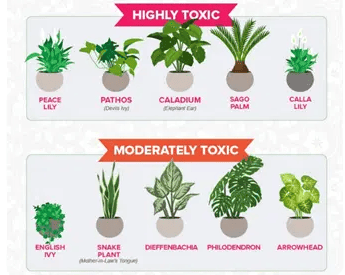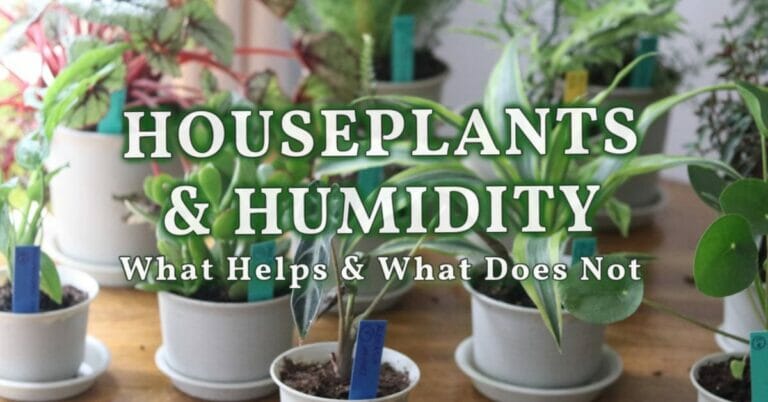
Are there any toxic houseplants to be aware of? Well, if you’re into sprucing up your living space with some greenery, it’s important to know which plants can be harmful.
Nobody wants to accidentally bring a toxic plant into their home and put their loved ones, including furry friends, at risk. So, in this article, we’ll explore some common houseplants that might not be as innocent as they seem, and what you need to watch out for. Let’s dive in!
Picture this: you’ve just finished decorating your living room with some beautiful new houseplants. They add a touch of nature and freshness to the space. But wait! Are those plants safe to have around, or could they be dangerous? It’s essential to be aware of whether the plants you bring into your home can be harmful to people or pets.
Sometimes, we assume that all plants are safe, but that’s not the case. Some houseplants can actually be toxic if ingested or touched, causing mild to severe reactions.
Don’t worry, we’re here to help you separate the harmless greens from the potentially dangerous. So, let’s make sure you have the knowledge you need to keep your space both beautiful and safe!
Are there any toxic houseplants to be aware of?
In order to keep your home safe and pet-friendly, it’s important to be aware of toxic houseplants. While many houseplants are safe, there are a few that can be harmful to humans and pets if ingested.
Some common toxic houseplants include lilies, philodendrons, and peace lilies. It’s always a good idea to research any plants before bringing them into your home to ensure they are safe for everyone in your household.
Danger Lurking in Your Home: A Guide to Toxic Houseplants
As much as we love the beauty and vibrancy that houseplants bring into our homes, it’s important to remember that some of them can pose a risk to our loved ones.
Whether you’re a seasoned plant parent or just starting your indoor gardening journey, being aware of toxic houseplants is crucial.
In this section, we’ll discuss some of the most common toxic houseplants you should avoid, providing detailed information about their potential effects and how to handle them responsibly.
Dumb Cane (Dieffenbachia)
Dumb Cane, scientifically known as Dieffenbachia, is a popular household plant known for its striking foliage and easy care requirements. While its large, variegated leaves can be visually appealing, it’s important to handle this plant with caution.
The leaves and stems of the Dumb Cane contain a toxic sap that can cause severe irritation and swelling if ingested or come into contact with the skin or eyes.
Symptoms may include difficulty swallowing, a burning sensation, and even temporary speech loss. It’s crucial to keep this plant out of reach of children and pets and to wash your hands thoroughly after handling it.
Peace Lily (Spathiphyllum)
The Peace Lily, with its elegant white blooms and lush foliage, is a popular choice for indoor gardening enthusiasts. However, despite its peaceful appearance, these plants can be toxic if ingested by curious pets or young children.
The Peace Lily contains calcium oxalate crystals, which can cause irritation and swelling of the mouth and throat, leading to difficulty breathing in severe cases.
It’s important to be cautious and keep this plant out of reach, or consider opting for pet-friendly alternatives if you have animals in your home.
English Ivy (Hedera Helix)
English Ivy is a widely recognized climbing vine known for its ornamental appeal and ability to purify the air. However, this plant contains substances called triterpenoid saponins, which can be toxic when ingested in large quantities.
Ingesting English Ivy can cause gastrointestinal discomfort, such as vomiting, diarrhea, and abdominal pain. It’s essential to keep this plant out of reach of children and pets, and to promptly seek medical attention if ingestion occurs.
Castor Bean (Ricinus Communis)
Although the Castor Bean is a stunning plant with its vibrant foliage and unique seed pods, it is important to handle it with caution due to its toxic properties.
The seeds of the Castor Bean plant contain a deadly toxin called ricin. Ingesting even a small amount of ricin can have severe consequences, including nausea, diarrhea, and difficulty breathing, and in extreme cases, it can be lethal.
Due to its high toxicity, it’s best to avoid growing Castor Bean plants in homes with young children or pets.
Pothos (Epipremnum Aureum)
Pothos, also commonly known as Devil’s Ivy, is a versatile trailing plant that is popular for its lush, heart-shaped leaves and easy care. While it is known for being relatively low maintenance, it’s important to note that Pothos is toxic to both humans and pets if ingested.
The plant contains calcium oxalate crystals, which can cause irritation and swelling of the mouth and throat. Symptoms may include burning and swelling of the lips, tongue, and oral tissues.
To ensure the safety of your loved ones, it’s recommended to keep Pothos plants out of reach and consider pet-friendly alternatives for your home.
Aloe Vera (Aloe Barbadensis)
Aloe Vera, with its succulent leaves and healing properties, has been popular for centuries. It’s commonly used for its gel, which can help soothe burns and skin irritations.
However, caution must be exercised when it comes to keeping Aloe Vera plants around pets. Ingesting the gel of Aloe Vera can lead to gastrointestinal upset in animals, including vomiting and diarrhea.
While it may not be severely toxic, it’s best to keep Aloe Vera plants in areas where pets cannot reach them to prevent ingestion.
Snake Plant (Sansevieria Trifasciata)
Snake Plant, also known as Mother-in-Law’s Tongue, is a popular choice for indoor greenery due to its beautiful and resilient nature. However, this plant contains toxic saponins, which can cause gastrointestinal distress if ingested.
Symptoms may include nausea, vomiting, and diarrhea. It’s important to keep this plant out of reach of children and pets, especially if they have a tendency to explore and nibble on plants.
How to Keep Your Loved Ones Safe: Tips for a Toxic-Free Home
Now that we’ve explored some common toxic houseplants, let’s shift our focus to creating a safe and toxic-free environment. Here are some tips to ensure that your loved ones, including children and pets, stay safe and healthy:
Research Your Houseplants:
Before bringing a new plant into your home, take the time to research its toxicity levels. Look for information on whether it is safe for children and pets, and familiarize yourself with the potential risks involved. This will allow you to make informed decisions about the plants you choose to have in your living space.
Place Plants Out of Reach:
Keep toxic houseplants in areas where they are inaccessible to children and pets. Consider utilizing hanging baskets, wall-mounted planters, or shelves that are out of their reach. This will provide an extra layer of protection and minimize the risk of accidental ingestion.
Teach Children about Plant Safety:
Take the time to educate children about the importance of not consuming or touching plants without adult supervision.
Teach them to admire plants from a safe distance and to seek assistance if they come across any plants they are unfamiliar with. This will help create a safer environment for them to explore and learn about the natural world.
Choose Pet-Friendly Alternatives:
If you have pets in your home, consider opting for pet-friendly houseplants that are non-toxic and safe for your furry friends. There are plenty of beautiful and low-maintenance options available, such as spider plants, Boston ferns, and areca palms, that will add beauty to your living space without compromising the safety of your pets.
Regularly Clean and Maintain Your Plants:
Regularly clean the leaves of your houseplants to remove any dust or potential toxins that may have settled on them. This will not only keep your plants healthy but also minimize the risk of accidental ingestion if your children or pets come into contact with them.
When it comes to houseplants, it’s essential to strike a balance between beauty and safety. While the majority of houseplants are harmless, it’s crucial to be aware of any potentially toxic species, particularly if you have children or pets in your home.
By educating yourself on the potential risks, proactively creating a safe environment, and opting for pet-friendly alternatives, you can enjoy the benefits of indoor plants without compromising the well-being of your loved ones. As always, prevention and knowledge are key to ensuring a toxic-free home.
Frequently Asked Questions
In this section, we’ll answer some common questions about the toxicity of houseplants and provide insights on plants to be aware of. Let’s dive in!
Why is it important to be aware of toxic houseplants?
It’s essential to be aware of toxic houseplants because some plants can be harmful to humans and pets if ingested. These plants contain toxins that can lead to symptoms ranging from mild irritations to severe poisoning.
Being informed about the toxicity of certain houseplants can help you ensure the safety of your family, especially if you have curious kids or pets who might be tempted to explore them.
By knowing which plants are toxic, you can take necessary precautions such as placing them in inaccessible areas or opting for non-toxic alternatives. Being aware can also help you recognize potential plant-related health issues and seek medical attention promptly if you or a loved one experiences any symptoms after exposure.
Are all houseplants toxic to humans and pets?
No, not all houseplants are toxic to humans and pets. While some plants contain toxins that can cause harm if consumed, many common houseplants are safe to have around. There is a wide range of non-toxic houseplants available that can add beauty to your living space without posing a risk.
It’s important to note that the level of toxicity can vary among plants. Some may have low toxicity, leading to mild symptoms, while others can be highly toxic and require immediate medical attention if ingested.
When selecting houseplants, it’s always a good idea to research their potential toxicity and consider the safety of your household members.
Which houseplants should I be aware of due to their toxicity?
There are a few common houseplants that you should be aware of due to their toxicity. One example is the popular Peace Lily (Spathiphyllum), which contains calcium oxalate crystals that can cause mouth and throat irritation if consumed.
Another is the Pothos (Epipremnum aureum), which can cause similar symptoms due to the presence of insoluble calcium oxalates.
The Dieffenbachia, also known as Dumb Cane, is another houseplant to be cautious about. Its sap contains needle-shaped calcium oxalate crystals that can cause intense mouth and throat irritation, leading to difficulty swallowing.
Other toxic houseplants include the Philodendron, Snake Plant, and ZZ Plant. It’s always a good idea to research specific houseplants before bringing them into your home.
What are some alternatives to toxic houseplants?
If you’re concerned about the toxicity of certain houseplants, there are plenty of non-toxic alternatives to choose from.
Consider adding plants like Spider Plant, Boston Fern, Areca Palm, or Rubber Plant to your living space. These plants not only add beauty and freshness to your home but are also safe for children and pets.
Spider plants are particularly popular as they are non-toxic and are known for purifying the air. Boston Ferns are another excellent choice, as they thrive in low light conditions and can bring an elegant touch to any room.
Researching and selecting non-toxic houseplants ensures you can enjoy the benefits of indoor greenery without compromising the safety of your household.
What should I do if someone ingests a toxic plant?
If someone ingests a toxic plant, it’s important to seek medical attention immediately. Stay calm and try to identify the plant if possible. Take note of any symptoms the person is experiencing and inform the medical professionals about the potential plant poisoning.
Do not induce vomiting unless instructed to do so by a medical professional, as this can have adverse effects depending on the plant ingested.
If you can safely bring a sample or a picture of the plant with you, it may help healthcare providers in determining the best course of action. Remember, swift medical intervention is crucial in cases of plant poisoning.
There are indeed toxic houseplants that can be harmful if ingested by pets or humans. It’s important to research and choose non-toxic plants for your home. Some common toxic plants to be aware of include lilies, philodendrons, and snake plants.
When shopping for houseplants, check the labels or ask for advice to ensure you’re choosing plants that are safe for your household. If you have pets or young children, take extra precautions by keeping toxic plants out of their reach.
Remember, with a little planning, you can still enjoy the beauty of indoor plants without any worry of toxicity. Stay safe and happy gardening!


